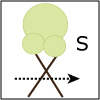Topics

|
|
Lecture Video
A catalyst is a substrate that speeds up a reaction without being consumed. Catalysts lower the activation energy barrier for a reaction without changing the equilibrium constant. In this lecture, catalysts of different types are introduced, including Nature’s catalysts, enzymes. We also hear from Chemist Jingnan Lu about why knowledge of kinetics is important for the development of biofuels.
Lecture Notes
Clicker Questions
Lecture 34 Clicker Questions (PDF)
Textbook Reading
| TOPICS | 5th EDITION | 4th EDITION |
|---|---|---|
| Catalysis | Section 14.14 | Section 13.14 |
| Living Catalysts: Enzymes | Section 14.16 | Section 13.16 |
Related Behind the Scenes at MIT Videos
Engineering Enzyme Pathways for Biofuel Development
Jingnan Lu’s research focuses on converting carbon dioxide, an environmental pollutant, into biofuel. Jingnan explains how she engineers a carbon-storing microorganism into a biofuel production pathway. She discusses kinetic parameters she is able to change, such as using a more efficient enzyme (a catalyst) and increasing substrate concentration to speed up the production of biofuels.
Jingnan Lu describes how she overcame the challenge of learning English as a teenager when she moved to the United States from China and realized from a research experience that she can use science to help people.










